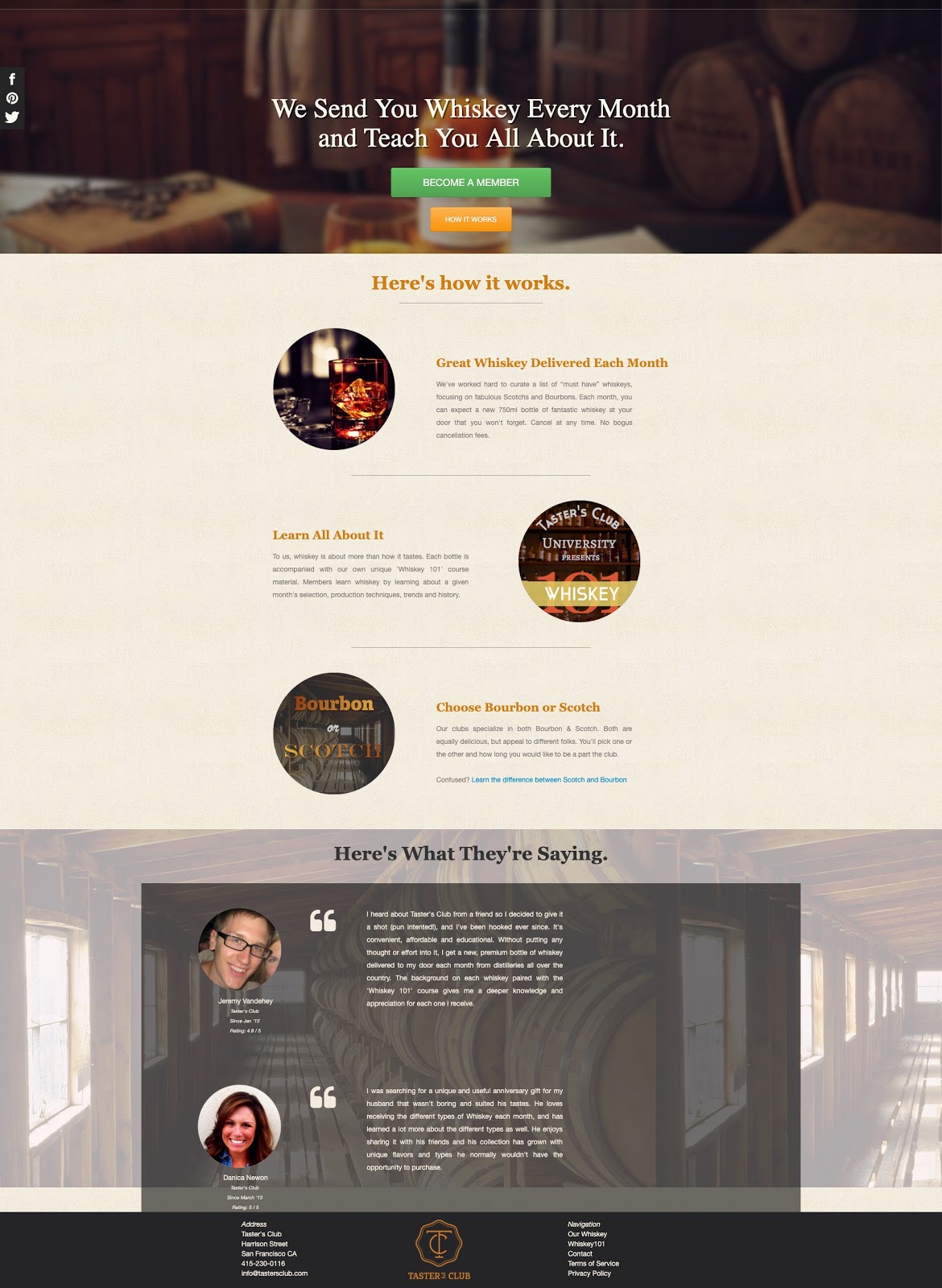How I Grew My Online Booze Business to $270K/Month
Hello! Who are you and what business did you start?
Hey! I’m Mack McConnell, founder of Taster’s Club, a subscription service for people who are curious to learn about and taste amazing craft spirits. Each month we send our members the most interesting spirits we can get our hands on and teach them all about it.
We originally started with just whiskey, but we’ve since expanded into 12 different tracks: whiskey, bourbon, scotch, tequila, rum, gin, vodka, wine or “stock the bar” (includes all the above). Regardless of what track a member chooses, what makes us special is not only that we source the best stuff from under-represented, amazing craft distillers across the world, but that we teach our members all about these spirits to give them the 360° experience of what they’re drinking.
I started Taster’s Club back in 2012, alone, from my room in San Francisco. I’ll never forget the feeling of getting that first subscriber, realizing that this idea might have legs. We’ve been lucky to have grown to share what we do with more and more people.
The business has come so far but we still run a very lean team comprised of independent contractors (equivalent of 3 full-timers) and we’re doing about $270K/month in revenue. We’re just excited to keep doing what we love, sharing what we love with anyone who will give it a try.

What's your backstory and how did you come up with the idea?
Back in 2012, I was living in San Francisco, working at a big tech company and got the bug to launch a business that aligns with my passions. At the same time, I was getting fascinated with craft spirits from across the world and also became obsessed with reading and learning about them.
Even under tight constraints (day job, family etc…) don’t underestimate the impact of focused, continuous work, even done a little at a time, every night for a year.
As I kept on buying/trying new stuff, it became obvious that the process of discovering spirits is old and boring; most people go to the store and probably pick out whatever it is they had last (or, even worse, something they saw a commercial for!). I wanted to create a way for people to get spirits that was more exciting, convenient and encourages discovery. I was getting stoked about this stuff and I wanted to bring people along with me.
Taster’s Club got its first subscriber in its first month; I was thrilled. I knew what I was trying to do might have legs but had to do it as a side-hustle. I moved to Paris, was working as a developer at a startup and was able to quit and work on it full-time around Taster’s Club’s first birthday.
This was mostly possible at the time because I was a bit of a swiss army knife, able to do most things on my own (web/app development, operations, design, operations, sales, marketing, negotiating with suppliers, etc..), except warehousing/shipping.
Take us through the process of designing, prototyping, and manufacturing your first product.
Because alcohol is so heavily regulated, we had no choice but to work with third party, licensed warehouse/shippers to work within certain states, which conveniently answered some key questions upfront (dropship or hold inventory?).
We began with select shippers only in select states. We were able to find them simply by figuring out who the leading e-commerce sites were working with.
Launching fast and lean was important because it allowed us to be the first to market (now there’s over 50 alcohol-related subscription services), let us define the category and gave important early lessons.
Finding a reliable means of serving customers in all 50 states has been a challenge from the start. Shipping alcohol directly to consumers requires a special kind of business license, and in many cases requires you to have a unique license for each state you’d like to serve. The “strictness” of regulations also varies widely from state-to-state, which means that trying to fulfill orders at scale would be a tedious, manual process if we took everything on ourselves. This made the decision between self-fulfillment and drop-shipping very simple.
It was going to be prohibitively complicated and expensive to fulfill orders ourselves within the boundaries of the law, so we decided to work with third party vendors who were already licensed, insured, and willing to order, hold, and ship products on our behalf.
To find these partners, we researched the current e-commerce sites that were delivering alcohol to their customers and reverse-engineered which states they were shipping to and how they were fulfilling orders.
( Note: These sites were basically online catalogs where customers could buy one-off bottles, not a subscription model like we had in mind.)
We started with one or two fulfillment partners and just a handful of “states served” and then expanded out as our revenue and customer base grew. As our transaction volume increased, so did our likelihood of landing new partnerships and getting more beneficial pricing terms.
We had some of the early challenges were around consistency of customer experience and planning. We were essentially responsible for the customer experience, but it was being administered by various, distributed retailers. For example, sometimes the bottle we needed would be available at retailer A, but we needed it at retailer B, etc.. Or we would run out of our custom boxes (which were expensive when we were small!) at one retailer but didn’t plan properly at the other because of unplanned demand. We just didn’t have the resources to handle the complexity (was just me back then!), so our solution was just to put all customers on one monthly schedule, so everyone would get shipments on the same day every month, even if that means waiting 3 weeks to get your first shipment. It serendipitously worked out: customers didn’t mind, I were able to plan inventory more intelligently and focus on growing the business.
Bottles broken in transit, late arrivals, missed delivery attempts (signature required for shipment!), etc. are part of the struggle. Every “fire” requires extra effort to put out because we have to be the middleman between the customer and the retailer operating behind the scenes.
The bottles we were sending members early on were easy to choose because – being a huge spirits fan – I just took people through a list of my personal favorites. Making the educational material that accompanied each bottle was cinch because most of it was stuff I (being a spirits geek) already knew. Remember, I was really just making a service that I would have wanted to find a year prior.
Describe the process of launching the business.

Our first website was based off a Wordpress template built for restaurant menus I was able to sort of edit to look close enough to what I imagined, making plenty of design sacrifices to launch fast and on the cheap.
A happy accident was that because we had to work with distributed retailers, we were able to make it so we didn’t need to buy product upfront, just according to orders that came in. So, the business literally required no capital to start, aside from the cost of the URL and Wordpress template. The business has continued that way, funded from its own profit.
An important lesson I learned is that launching fast and lean was important because it allowed us to be the first to market (now there’s over 50 alcohol-related subscription services), let us define the category and gave important early lessons.
Since launch, what has worked to attract and retain customers?
What really worked for us is to stick to our mission: getting people excited about craft spirits. Just like any business, we made a million small decisions along the way, and to our credit, I think we did a good job at staying focused on the impact we were trying to bring to our members.
With respect to growth , we’ve found some success with paid advertising, social media, content marketing, and email.
Our general recommendation is to segment your audience and speak directly to their specific needs/interests. You might be surprised to learn that vodka aficionados are very different from whiskey connoisseurs in both language and behavior. Tailoring our message to specific audiences has dramatically increased engagement.
Some of the segments we have created include: club type (Ex: whiskey, vodka, rum, etc.), active members, past members, self-purchasers, gift givers, gift recipients, non-members, new members (first 45 days), and recently cancelled members (last 7 days).
We also have the ability to create new segments on the fly using information stored in our member database. For example, if there is a snowstorm forecasted to pummel the Northeast, we can pull all active members in the affected states and let them know that their shipment will likely be delayed due to inclement weather.
Customer segmentation is a huge advantage for us because it allows us to personalize our email marketing to address the specific context and needs of an individual member. Where most ecommerce stores would just push out an “email blast” to their entire list around Christmas, we’re able to say something like this instead:
“Hey John* ,*
Christmas is right around the corner...can you believe it?!
Last year you bought Jane Smith* a* 6-month subscription* to our* Whiskey of the Month* club. It looks like the subscription ran out in June, but we thought she might have loved it so much that she would enjoy getting it again this year.*
If you’re still looking for the perfect gift, we’ve got an active promotion going on that will save you $15 off your first bottle when you start or renew a gift subscription.
Interested? Click here to cross Jane* off your Christmas list.”*
Each of those bolded phrases is an area that can be automatically tailored to the recipient based on the information we have in our customer database. That means we write a single email template and our marketing software does all of the personalization for us.
Now, which campaign do you think gets more opens, click, and conversions? The generic “shotgun blast” email template that delivers the same message to everybody or the highly targeted, timely, contextual pitches that we’re using?
HINT: It’s not the first one.
Another recent win for us was layering in an abandoned cart sequence. It took half a day to set up, gets a 43% open rate and almost a 5% conversion rate. Free money!
By far, our best growth tactic is providing an outstanding customer experience, from the order process to receiving their first bottle to the unlikely event of needing to contact support. Word of mouth referrals are extremely powerful and we earn them every day by going above and beyond for our members.
The bulk of our traffic comes from organic search, which is the result of years of just “showing up,” building relationships, and publishing great content that people in our target audience actually want to read and share. Thanks to our content strategy and our PR efforts, we hold the top rank(s) for several high traffic keywords that have a specific purchase intent, which means that we get a fair amount of qualified site visitors that actually have a strong likelihood of converting to members.
We also get a substantial amount of traffic from high profile referral sources like Esquire Magazine, The Huffington Post, Buzzfeed, and Whiskey Advocate. This is often a spotlight feature of our product offering or inclusion in a “Best Gifts for _____” piece. The latter is an especially nice opportunity, because most publications will update these from year-to-year and carry over the best ideas, so we end up seeing a regular bump in traffic around the same time each year.
Paid advertising (search and social media) rounds out our biggest traffic sources, but it’s a much smaller piece of the pie. We don’t typically invest a lot in advertising outside of holiday seasons and special events, because we haven’t needed the extra boost.
To make sure that our traffic continues to increase year over year, we’re doubling down on the things that are working (Ex: blogging, on-page optimization, and PR) while also exploring new channels like influencer marketing, sponsorships, and affiliate programs.
With respect to retention , our focus on the customer experience helps with that as well. Our members renew their subscriptions at a high rate because we prioritize reliable service and helpful support every step of the way.
We have also tried to turn new members into repeat purchasers by launching a members-only bottle shop where they can buy additional bottles of their favorite past selections. These one-off sales are a growing part of our total revenue and help us liquidate any excess inventory.
Finally, we try to layer in stories and real-world experiences wherever possible. We publish spotlights of featured distilleries and do a deep dive into their history and processes. Here are a few examples we published for Cotswolds Distillery, Cleveland Whiskey, and Laws Whiskey House.
When customers get to know the people behind the product, whether that’s Taster’s Club itself or the producers of the spirits we select, there is a natural connection that starts to form and makes them less likely to churn.
How are you doing today and what does the future look like?
We’re profitable and 100% of our sales are done through our online store.
We serve thousands of members each month in every state except Alabama, Alaska, Arkansas, Delaware, Hawaii, Kentucky, Mississippi, North Dakota, Oklahoma, and Utah.
We start processing orders on the 1st of the month and have an internal goal of getting everyone a “bottle in hand” by the 15th of the month.
We have a team comprised of marketing, member happiness, operations, and editorial staff. James Sowers is running the company these days and is doing an amazing job.
We recently launched a new wine club just in time for Mother’s Day 2019 (LINK) and have a list of other clubs/regions we’d like to grow into over the long term.
Through starting the business, have you learned anything particularly helpful or advantageous?
We really benefited from a couple of intersecting trends when we were getting started: subscription services and craft spirits. We were really in the right place at the right time.
Have separation between you and your project. If it fails, it doesn’t mean you failed. This is the mindset that makes it easy to try again.
Regarding partnerships, one of the best decisions we’ve made is to partner with the craft distillers we love most. We’ve been able to make countless collaborations with distilleries, so Taster’s Club members often get bottles that are only available through our club. It’s been a great source of acquisition for people to know that we are the only places some of these collaboration releases are available.
A lesson I learned was not building a robust team fast enough. We eventually got there, but it took me a few years when we frankly could have done it sooner. In the meantime, I was driving myself crazy doing everything from web development to customer service to sales to operations. I frankly had a lot of burnout around year 4 I had to recover from. It was such a game changer for the business when we hired Andrew, our amazing Director of Operations.
What platform/tools do you use for your business?
- Website: Custom, Ruby on Rails
- Member Shop: Shopify, Back In Stock
- Blog: Wordpress
- Payments/Subscription Management: Stripe
- Order/Inventory Management: MailParser
- Email Marketing: Customer.io
- Referral Campaign: iRefer
- Social Media: Recurpost
- Payment Recovery:** **ProfitWell Retain
- Customer Support: HelpScout
- Customer Happiness: AskNicely
- Process Automation: Zapier
What have been the most influential books, podcasts, or other resources?
My mom is my biggest single inspiration in entrepreneurship. I’ve watched her do some amazing stuff, most recently found and run her non-profit Let It Be Us to increase adoption in the foster care population in Illinois.
She taught me to do things that are important and to stay focused on them. Aside from her I try to surround myself with people that inspire me and can act as a sounding board, entrepreneurs and people with other diverse experiences.
Other than people, my favorite book for entrepreneurs is The Four Steps to the Epiphany, which helps demystify the process of finding product market fit.
Advice for other entrepreneurs who want to get started or are just starting out?
- Do the thing you can’t stop thinking about.
- Fall in love with the problem, not the solution.
- Have separation between you and your project. If it fails, it doesn’t mean you failed. This is the mindset that makes it easy to try again.
- Even under tight constraints (day job, family etc…) don’t underestimate the impact of focused, continuous work, even done a little at a time, every night for a year.
Where can we go to learn more?
- TastersClub.com
- Facebook.com/tastersclub
- twitter.com/tastersclub
- https://www.instagram.com/tastersclub/
If you have any questions or comments, drop a comment below!

Download the report and join our email newsletter packed with business ideas and money-making opportunities, backed by real-life case studies.

Download the report and join our email newsletter packed with business ideas and money-making opportunities, backed by real-life case studies.

Download the report and join our email newsletter packed with business ideas and money-making opportunities, backed by real-life case studies.

Download the report and join our email newsletter packed with business ideas and money-making opportunities, backed by real-life case studies.

Download the report and join our email newsletter packed with business ideas and money-making opportunities, backed by real-life case studies.

Download the report and join our email newsletter packed with business ideas and money-making opportunities, backed by real-life case studies.

Download the report and join our email newsletter packed with business ideas and money-making opportunities, backed by real-life case studies.

Download the report and join our email newsletter packed with business ideas and money-making opportunities, backed by real-life case studies.














